上海牛津小学英语语法知识总结
上海牛津小学英语语法

上海牛津小学英语语法全第1讲字母1、英语中共有26个字母。
Aa,Ee,Ii,Oo,Uu是元音字母,Yy是半元音字母,其余是辅音字母。
英语单词就是由这26个字母组合而成的。
Aa和Ii可以独立成词,分别表示“一个(张……)”和“我”的意思,Ii翻译成“我”时要大写。
2、英语字母可以分为印刷体和书写体。
在书、报、杂志上见到的一般都是印刷体。
在四线三格上书写时应注意书写位置,可以记住以下口诀:大写字母不顶格,小写字母占满格。
书写时还要注意字母的笔顺。
3、英语句子的第一个单词的首字母要大写。
单词与单词之间在书写时必须保持适当的距离,一般以空出一个小写字母的宽度为宜。
句子的末尾要有标点符号。
4、英语中的句号是一个实心圆点(.),省略号是三个居下的实心圆点(…),英语中没有顿号和书名号,顿号用逗号替代,书名用斜体字表示。
5、英语缩写词PRC中华人民共和国UN 联合国WHO 世界卫生组织NBA美国职业篮球联赛KFC 肯德基IT 信息技术EQ 情商CCTV 中国中央电视台kg 千克a.m. 上午USA 美国HK 香港WTO 世界贸易组织CBA 中国男子篮球联赛ATM 自动柜员机ID 身份证CPU 中央处理器BBC 英国广播公司cm 厘米p.m. 下午UK 英国SOS 国际求救信号UFO 不明飞行物VIP 贵宾EMS邮政特快专递IQ 智商RMB 人民币VOA 美国之音No. 号码6第2讲语音1、音素:语音的最小单位。
2、元音:发音时气流不受阻碍。
元音分为单元音和双元音两类。
单元音发音时唇形和舌位不变;双元音发音时由一个元音向另一个元音滑动,唇形和舌位有一个变化过程,且前重后轻,前长后短。
3、辅音:发音时气流受到阻碍。
辅音分为清辅音和浊辅音两类。
清辅音发音时声带不振动;浊辅音发音时声带振动。
4、音标:用来记录音素的符号。
为了避免与字母混淆,音标被放在斜括号/ /内。
5、英语中的一个字母或字母组合在不同的单词中发音可能是不一样的,而相同的发音对应的字母或字母组合也可能不完全相同。
(完整版)上海牛津小学英语语法知识总结

上海牛津小学英语语法知识总结一般现在时1、定义:表示经常发生或习惯性的动作、状态。
句中通常有usually,often,every day,sometimes,always,at weekends,on Sundays等表示经常性时间的短语。
2、构成:1)当谓语是be动词时,一般现在时的构成:主语+be动词+其他如:I am a student. He is Jim’s father.They are from Japan.2)当谓语是行为动词时,一般现在时的构成:①主语(非第三人称单数)+动词原形+其他如:I often watch TV at the weekends.Mr Green and Mrs Green like collecting stamps.②主语(第三人称单数)+动词的第三人称单数形式+其他如:Jim usually visits his grandparents on Sundays.She sometimes goes to the park with her mother.3、动词三单形式的变化规则:•一般情况下,直接加s 如:read-reads,swim-swims•以s,x,sh,ch,o结尾,加es 如:wash-washes,watch-watches,do-does•以辅音字母+y结尾,变y为i,再加es 如:study-studies,fly-flies•不规则变化如:have-has4、一般现在时的句型转换:肯定句否定句一般疑问句及回答They watch TV every day. They don’t watch TVevery day.—Do they watch TV every day?—Yes, they do. / No, they don’t.She watches TV every day. She doesn’t watchTV every day.—Does she watch TV every day?—Yes, she does. / No, she doesn’t.现在进行时1、定义:表示现在或现阶段正在进行或发生的动作。
上海牛津版小学英语语法
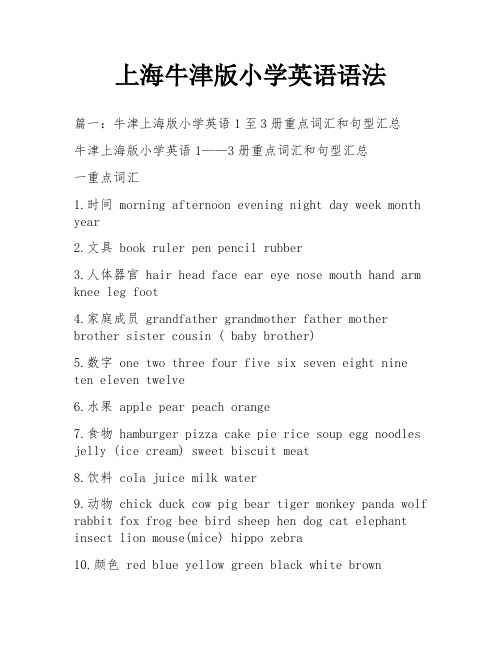
上海牛津版小学英语语法篇一:牛津上海版小学英语1至3册重点词汇和句型汇总牛津上海版小学英语1——3册重点词汇和句型汇总一重点词汇1.时间 morning afternoon evening night day week month year2.文具 book ruler pen pencil rubber3.人体器官 hair head face ear eye nose mouth hand arm knee leg foot4.家庭成员 grandfather grandmother father mother brother sister cousin ( baby brother)5.数字 one two three four five six seven eight nine ten eleven twelve6.水果 apple pear peach orange7.食物 hamburger pizza cake pie rice soup egg noodles jelly (ice cream) sweet biscuit meat8.饮料 cola juice milk water9.动物 chick duck cow pig bear tiger monkey panda wolf rabbit fox frog bee bird sheep hen dog cat elephant insect lion mouse(mice) hippo zebra10.颜色 red blue yellow green black white brown11.天气 sunny cloudy rainy windy warm hot cool cold12.季节 spring summer autumn(fall) winter13.服装 T-shirt dress shorts blouse shirt14.动词 dance read sing draw give thank see look do love eat drink help cut stick colour fly go hearlisten taste smell touch stand sitlike go e play wantride skip fold write help run jump pick swim put use wonder twinkle hop take fall close climb crytell15.形容词 fine fat thin tall short nice little round juicy sweet high yummy super happymerry new old young good bad poor big small dear ready bright smooth soft cute naughty sorry beautiful16.人称代词 I(me) you(you) she(her) he(him) it(it)we(us) you(you) they(them)17.物主代词 my your his her its our your their18.介词in on under for to with at like19.其它 house flower can who is are howstory bye goodbye hello please this thatthese those theand no not what classmate schoolschoolmate friend paper many (how many) here may have has had was there(there is) (there are) park zoo up down very name kite birthday song weather again away another beach rain bicyclegiftrope card firecracker firework all narrator farmer where boy girl man woman ballnoon treedollslide swing ball Miss Mrs Mr bag stick supergirlsuperboy superman but can’t don’t isn’t aren’twhat gate plate fork knifechopsticks bowl spoon jar seesaw colour game net box desk chair tablegueen sun moon star sky diamond grass animal food umbrella van window tree or lie age二重点句型1. Hello! Goodbye! Good morning ! Good afternoon!2.I’m Liu Yian.3. Give me a ruler,please ! Here you are ! Thank you !4. How nice !5. This is my ear !6. Alice, touch your eye !7. What can you do ? I can draw !8. Who is she ? She’s my mother!9. This is my father ! This is Kitty. She’s my friend. She’s thin. 10. How many books? Two books.11. Pears,please! How many pears? Three pears. I love to eat! 12. Can I help you? May I have a pie, please? Here you are ! Thank you! 13. What’s this? It’s a chick. What’s that? It’s a cow. 14. Is that a monkey? Yes. Is this a bear ? No, it’s a panda. 15. There’sa lion in the zoo ! What colour is it ? It’s brown.16.Colour the rubber green . 17. What do you see ? I see a panda. What do you hear ? I hear a pig. 18.Taste the noodles,Tom. Yummy,Yummy. Smell the soup, please. It’s nice. 19.Can I help you ? Soup, please . Here you are . Thank you. (Thank you very much. ) 20. Stand up ! Sit down ! 21. I like the ball. I like kites. 22. Do you like sweets ? No. Do you like jelly? Yes, I like jelly! 23. One for you and one for me!24.Drink some water, Mum. Thank you. 26. You are a good girl. 27. What do you like ? I like milk. 28. Happy birthday ,Liu Yian. Thank you! Let’s sing a birthday song. 29. Spring is warm. Summer is hot. Autumn is cool. Winter is cold. 30. In summer,it’s hot. I drink some juice.31. How is the weather? It’s sunny. Let’s go to the beach.32. What do you need ? I need a new dress. I don’t like brown, Mum. I like red. 33. Skip myrope ,my friend. 34. A gift for you! Happy newyear !35. Where’s the wolf ? 36. Here es the wolf . 37. Don’t tell a lie. You’re a bad boy. 38. Howare you , Liu Yian. I’m fine , thank you. 39. I’m Liu Yian. I’m a boy. I’m short and thin.40. Who am I ?41. I’m big. You’re small. Is it a cat ? Yes , it’s a cat. Is it a dog ? No, it isn’t. 42. Are you a boy? Yes. Are you seven ? No, I’m nine. 43. Can you draw ? Yes, I can . Can you swim ? No, I can’t. What can she do ?She can fly.44. She has a plate in her hands. Who’s she ? She’s Sally. Is she your sister ? Yes, she’s my sister.Is that a boy? No, she’s a girl. Is she fat ?Yes.Harry has an insect in a jar. 45. I have a good friend. His nam e is Zhang Peng. He’s big and tall. His hair is short . He has a round face.His eyes are big. 46. What can you see ? I can see a swing . What colour is it ? It’s yellow. 47. Put the box on the chair, please. OK/ All right, Dad. 48. I love my room like Kitty and Ben. I use the box every day ! I keep it cleanevery day ! 49. Come and eat the orange. 50. Dinner is ready ! I’m ing. Give me a plate, please. Here you are. 51. This is my kitchen. How many bowls ? Thereare four bowls. There is a table and a chair in the room. There are two bowls on the table. There is a cat under the table. 52. The queen is fat. She’s sitting on the chair. 53. Look at the sky . Can you see the moon? Yes, I can. 54. How I wonder what you are. 55. Tom’s rabbit sits on the table. Loo k at the lion. It’s big. It likes grass. Look at the hippo’s mouth. It’s so big. 56. She takes two umbrellas to her friends. Raindrops fall on her head.57. Don’t climb the tree. I’m sorry. 58. What animal is it? It’s a rabbit. What colour is it ? It’s whi te. Is it big or small ? It’s small.What does it like ?It likes grass.篇二:牛津上海版五年级英语语法测试牛津上海版五年级英语语法总测试be/do/ have1.Theyplaying football at school..he go to the cinema yesterday?3. Kitty and Ben at their father’s workshop now.your father buy a motorbike for your birthday last week?5.There some apple juice in this bottle.6. your brother like the Car Museum?7.There three birds on the tree,but now there seven birds on it.8.What class do we today?9.Theymy glue and paints.10.Whose glasses these?物主代词&人称代词翻译:他是我的朋友。
“牛津上海版”小学英语二年级(上)知识点大全
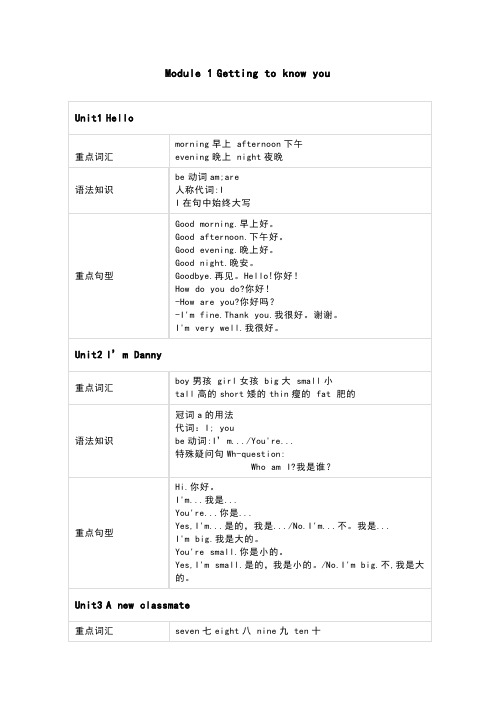
Unit2 That's my family
重点词汇 语法知识 重点句子
young 年轻的 old 老的 kind 体贴的 nice 友好的 sweet 惹人喜爱的 jar 罐子 t 昆虫
人称代词:she,he 物主代词:my,your 一般疑问:Is he/she...?
Yes,he/she is. No,he/she isn't. be 动词:He/She is... 特殊疑问句:Wh-question:
可数名词-复数 介词:in.on,under 特殊疑问句:How many...? There be 句型:There is/are... 祈使句:Give me...,please.
No,thanks.不需要,谢谢。 Yes,please.是的,请给我。 Here you are.给你。 Dinner is ready.晚餐准备好了。 I'm coming.我来了。 Give me a plate,please.请给我一个盘子。 How many bowls?多少碗? There are four bowls.有 4 个碗。 How many spoons?多少勺子? There is one.有一个勺子。 There is a table and a chair in the room.房间里 有一张桌子和一把椅子。 There are two bowls on the table.桌子上有两个碗。 Ginger is under the chair.生姜在椅子下面。 He's sitting under the chair.他在椅子下面坐着。
Unit3 A new classmate
重点词汇
seven 七 eight 八 nine 九 ten 十
“牛津上海版”小学英语三年级(下)知识点大全
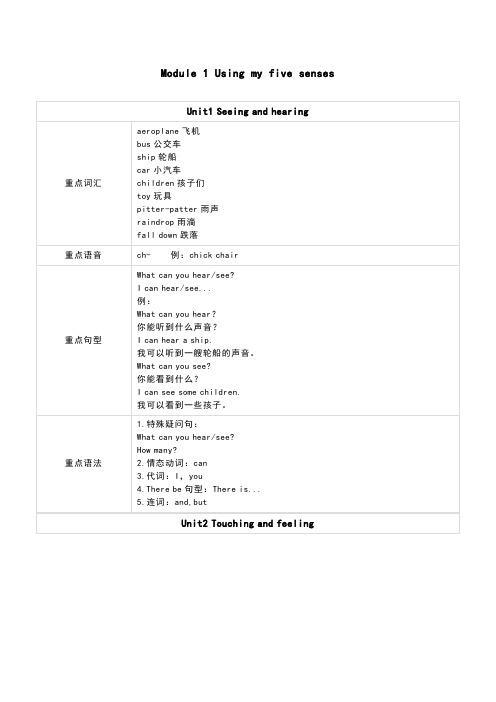
Do you like...? Yes,I do./No,I don’t. 例: Do you like elephants? 你喜欢大象吗? Yes,I do. 是的,我喜欢。 Do you like tigers? 你喜欢老虎吗? No,I don’t. 不,我不喜欢。
I have... My...is/are... 例:I have two eyes.My eyes are big. 我有两个眼睛。我的眼睛大。
Of course.当然。
1.动词 have:I have... 2.一般疑问句:Can you...? 3.Be 动词: These are... They are... 4.代 词 : my,me,myself,yourself
May I have a try? Sure. 我能试下吗?当然。
1.特殊疑问句: What is it? What’s this/that? What are these/those? 2.一般疑问句: Are they...? 3.Be 动词:It's/They're...
重点词汇 重点语音
重点句型
补充句型 重点语法
Module3 Things around us
Unit1 Shapes
circle 圆形 square 正方形 triangle 三角形 star 星形 rectangle 长方形
-ff 例:turn off take off
What shape is it? 它是什么形状的? It’s a circle. 它是一个圆形。
重点语法
1. 祈 使 句 : 动 词 原 形 开 头 例:Close your eyes./Smell this. 2. 特 殊 疑 问 句 : How does it smell/taste? What is it? 3.一般疑问句:Is it...? 4.Be 动词:It's...
上海小学牛津英语语法归纳总结
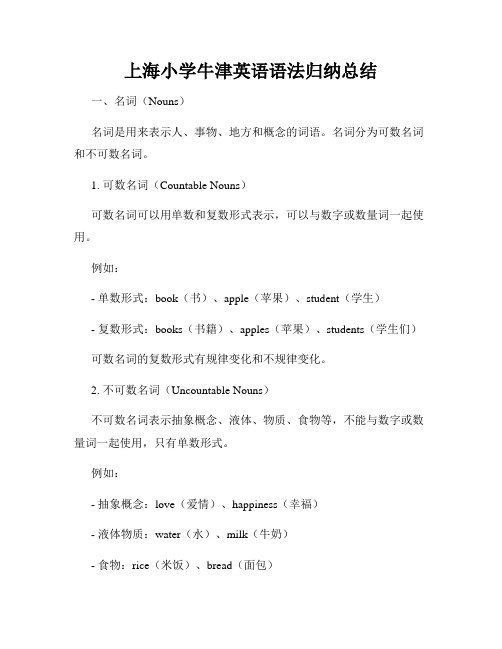
上海小学牛津英语语法归纳总结一、名词(Nouns)名词是用来表示人、事物、地方和概念的词语。
名词分为可数名词和不可数名词。
1. 可数名词(Countable Nouns)可数名词可以用单数和复数形式表示,可以与数字或数量词一起使用。
例如:- 单数形式:book(书)、apple(苹果)、student(学生)- 复数形式:books(书籍)、apples(苹果)、students(学生们)可数名词的复数形式有规律变化和不规律变化。
2. 不可数名词(Uncountable Nouns)不可数名词表示抽象概念、液体、物质、食物等,不能与数字或数量词一起使用,只有单数形式。
例如:- 抽象概念:love(爱情)、happiness(幸福)- 液体物质:water(水)、milk(牛奶)- 食物:rice(米饭)、bread(面包)不可数名词没有复数形式,不能直接与冠词a/an连用。
二、冠词(Articles)冠词用于限定名词的范围,分为定冠词和不定冠词。
1. 定冠词(Definite Article)定冠词是"the",用于特指已经提到的人或物,或者特指上下文中的某人或某物。
例如:- I saw a cat in the tree.(我看到树上有一只猫)- The cat was black.(那只猫是黑色的)2. 不定冠词(Indefinite Article)不定冠词有两种,分别是"a"和"an"。
用于泛指某一类人或物。
例如:- I have a dog.(我有一只狗)- She is an actress.(她是一名女演员)不定冠词"a"后面接辅音音素开头的词,"an"后面接元音音素开头的词。
三、形容词(Adjectives)形容词用来描述名词的特征和性质。
形容词通常位于名词之前。
- a big house(一个大房子)- a beautiful flower(一朵美丽的花)形容词可以用于比较级和最高级。
牛津上海版小学英语1至3册重点词汇和句型汇总
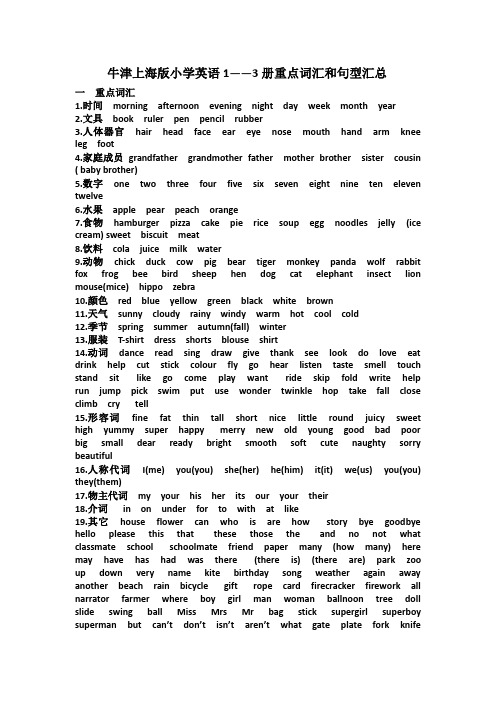
牛津上海版小学英语1——3册重点词汇和句型汇总一重点词汇1.时间morning afternoon evening night day week month year2.文具book ruler pen pencil rubber3.人体器官hair head face ear eye nose mouth hand arm knee leg foot4.家庭成员grandfather grandmother father mother brother sister cousin ( baby brother)5.数字one two three four five six seven eight nine ten eleven twelve6.水果apple pear peach orange7.食物hamburger pizza cake pie rice soup egg noodles jelly (ice cream) sweet biscuit meat8.饮料cola juice milk water9.动物chick duck cow pig bear tiger monkey panda wolf rabbit fox frog bee bird sheep hen dog cat elephant insect lion mouse(mice) hippo zebra10.颜色red blue yellow green black white brown11.天气sunny cloudy rainy windy warm hot cool cold12.季节spring summer autumn(fall) winter13.服装T-shirt dress shorts blouse shirt14.动词dance read sing draw give thank see look do love eat drink help cut stick colour fly go hear listen taste smell touch stand sit like go come play want ride skip fold write help run jump pick swim put use wonder twinkle hop take fall close climb cry tell15.形容词fine fat thin tall short nice little round juicy sweet high yummy super happy merry new old young good bad poor big small dear ready bright smooth soft cute naughty sorry beautiful16.人称代词I(me) you(you) she(her) he(him) it(it) we(us) you(you) they(them)17.物主代词my your his her its our your their18.介词in on under for to with at like19.其它house flower can who is are how story bye goodbye hello please this that these those the and no not what classmate school schoolmate friend paper many (how many) here may have has had was there (there is) (there are) park zoo up down very name kite birthday song weather again away another beach rain bicycle gift rope card firecracker firework all narrator farmer where boy girl man woman ballnoon tree doll slide swing ball Miss Mrs Mr bag stick supergirl superboy superman but can’t don’t isn’t aren’t what gate plate fork knifechopsticks bowl spoon jar seesaw colour game net box desk chair table gueen sun moon star sky diamond grass animal food umbrella van window tree or lie age二重点句型1. Hello! Goodbye! Good morning ! Good afternoon!2. I’m Liu Yian.3. Give me a ruler,please ! Here you are ! Thank you !4. How nice !5. This is my ear !6. Alice, touch your eye !7. What can you do ?I can draw ! 8. Who is she ? She’s my mother! 9. This is my father ! This is Kitty. She’s my friend. She’s thin.10. How many books? Two books. 11. Pears,please! How many pears? Three pears.I love to eat! 12. Can I help you? May I have a pie, please? Here you are ! Thank you! 13. What’s this? It’s a chick.What’s that? It’s a cow. 14. Is that a monkey? Yes. Is this a bear ? No, it’s a panda. 15. There’s a lion in the zoo ! What colour is it ? It’s brown. 16. Colour the rubber green . 17. What do you see ? I see a panda. What do you hear ? I hear a pig. 18. Taste the noodles,Tom. Yummy,Yummy. Smell the soup, please. It’s nice. 19.Can I help you ? Soup, please . Here you are . Thank you. (Thank you very much. ) 20. Stand up ! Sit down ! 21. I like the ball. I like kites. 22. Do you like sweets ? No. Do you like jelly? Yes, I like jelly! 23. One for you and one for me!24. Drink some water, Mum. Thank you. 26. You are a good girl. 27. What do you like ? I like milk. 28. Happy birthday ,Liu Yian. Thank you! Let’s sing a birthday song. 29. Spring is warm. Summer is hot. Autumn is cool. Winter is cold. 30. In summer,it’s hot. I drink some juice.31. How is the weather? It’s sunny. Let’s go to the beach. 32. What do you need ? I need a new dress. I don’t like brown, Mum. I like red. 33. Skip my rope ,my friend. 34. A gift for you! Happy new year ! 35. Where’s the wolf ? 36. Here comes the wolf . 37. Don’t tell a lie. You’re a bad boy. 38. How are you , Liu Yian. I’m fine , thank you.39. I’m Liu Yian. I’m a boy. I’m short and thin. 40. Who am I ? 41. I’m big. You’re small. Is it a cat ? Yes , it’s a cat. Is it a dog ? No, it isn’t. 42. Are you a boy? Yes. Are you seven ? No, I’m nine. 43. Can you draw ? Yes, I can . Can you swim ? No, I can’t. What can she do ? She can fly. 44. She has a plate in her hands. Who’s she ? She’s Sally. Is she your sister ? Yes, she’s my sister. Is that a boy? No, she’s a girl. Is she fat ? Yes. Harry has an insect in a jar. 45. I have a good friend. His name is Zhang Peng. He’s big and tall. His hair is short . He has a round face. His eyes are big. 46. What can you see ? I can see a swing . What colour is it ? It’s yellow. 47. Put the box on the chair, please. OK/ All right, Dad. 48. I love my room like Kitty and Ben. I use the box every day ! I keep it cleanevery day ! 49. Come and eat the orange. 50. Dinner is ready ! I’m coming. Give me a plate, please. Here you are. 51. This is my kitchen. How many bowls ? There are four bowls. There is a table and a chair in the room. There are two bowls on the table. There is a cat under the table. 52. The queen is fat. She’s sitting on the chair. 53. Look at the sky . Can you see the moon? Yes, I can. 54. How I wonder what you are. 55. Tom’s rabbit sits on the table. Look at the lion. It’s big. It likes grass. Look at the hippo’s mouth. It’s so big. 56. She takes two umbrellas to her friends. Raindrops fall on her head.57. Don’t climb the tree. I’m sorry. 58. What animal is it? It’sa rabbit. What colour is it ? It’s white. Is it big or small ? It’s small. What does it like ? It likes grass.。
“牛津上海版”小学英语四年级(上)知识点大全
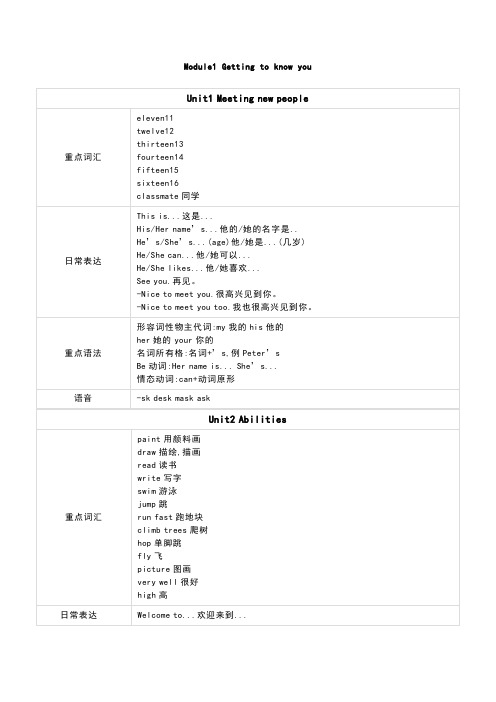
always 总是
日常表达 重点语法
语音
Merry Christmas!圣诞节快乐!
特殊疑问句: -How’s the weather in...?-It’s... What are they? Be 动词:It’s... There be 句型:There are... 情态动词:can 一般疑问句: A:Do you like...? B:Yes,I do./No,I don’t.
特殊疑问句:How do you feel? 表达感受的形容词: happy,sad,thirsty... Be 动词:I’m...We’re...He’s... A:How do you feel? B:I’m/We're happy,sad,thirsty...
名词所有格:名词+’s,例 Ginger’s There be 句型:There is/are... 一般疑问句:Are you...? 祈使句:动词原形开头,例 Come in, please.请进。
canteen 餐厅 computer lab 机房 office 办公室 gym 体育馆 behind 在...后面 in front of 在...前面 building 建筑物 lesson 课程 lunch 午餐 hall 礼堂;大厅 playground 操场 classroom 教室 library 图书馆 cupboard 橱柜 bookshelf 书架 desk and chair 桌椅 pencil case 铅笔盒 rubber 橡皮 pencil 铅笔 notebook 笔记本
Module4 The natural world
重点词汇
重点语法 语音
重点词汇
Unit1 A visit to a farm
沪教牛津版英语三年级上册词组语法

沪教牛津版英语三年级上册词组语法沪教牛津版英语三年级上册是一本教材,旨在帮助学生掌握基础的英语词组和语法知识。
以下是相关参考内容:一、词组1. Hello/Goodbye- Hello, how are you?- Goodbye, see you later.2. How old are you?- I'm six years old.3. What's your name?- My name is Tom.4. Nice to meet you.- Nice to meet you too.5. What color is it?- It's red/green/blue/yellow.6. How many?- How many pencils do you have?7. Where is it?- It's on/under/in/behind/near the table.8. What do you have?- I have a book/pencil/bag.9. How do you go to school?- I go to school by bus/by bike/on foot.10. What's the weather like?- It's sunny/cloudy/windy/rainy.二、语法1. Be动词的用法- I am happy.- You are my friend.- He is a teacher.- She is a doctor.- It is a cat.- We are in the park.- They are students.2. 人称代词的用法- I am a student.- You are my friend.- He is a teacher.- She is a doctor.- We are in the park.- They are students.3. 冠词的用法- This is a pencil.- That is an apple.- I have an eraser.- She has a doll.- We are playing with a ball.4. 名词的复数形式- I have two pencils.- They are my friends.- We have three books.5. 人称代词的所有格- This is my pen.- That is your book.- It is his/her bag.- These are our toys.- Those are their bikes.6. 一般现在时的用法- I like to play soccer.- He likes to read books.- She likes to sing songs.- We like to eat ice cream.- They like to watch movies.7. 一般疑问句的构成- Do you like to dance?- Does he like to swim?- Does she like to play tennis? - Do we like to cook?- Do they like to paint?8. 物主代词的用法- This is mine.- That is yours.- It is his/hers.- These are ours.- Those are theirs.9. 数词的用法- I have one apple.- She has two cats.- They have three dogs.10. 时间状语的用法- I get up at 7 o'clock.- She goes to bed at 9 o'clock.- We have English class on Monday.- They go to the park in the morning.以上是沪教牛津版英语三年级上册的词组和语法相关参考内容。
“牛津上海版”小学英语四年级(下)知识点大全
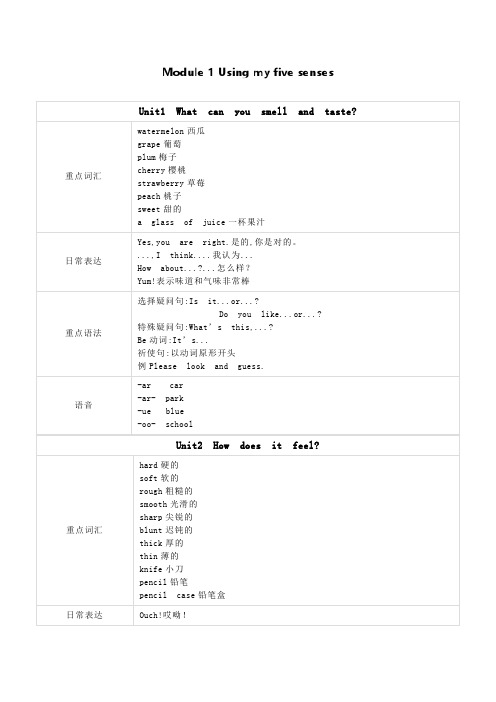
Unit1 A music class
piano 钢琴 violin 小提琴 triangle 三角铁 drum 鼓 music 音乐
特殊疑问句:What can you Whose...is it? Where’s...? 一般疑问句:Is that...?
play?
Unit2 Festivals in China
is sits
What time is it?几点了? It’s so much fun.好有趣。 It’s time for...到做...的时间了 All right.好的。
特殊疑问句:What are you doing? What time is it?
语音
重点词汇
重点语法 语音
关于时间的表达:例 seven o'clock, a quarter past seven, half past seven, a quarter to eight
频率副词:always,usually,often... 一般现在时:例 Peter goes to school from Monday to Friday. 介词:on
-ay May -ai- wait
重点词汇 重点语法
重点词汇 日常表达 重点语法
重点词汇
Module 4 More things to learn
the Spring Festival 春节 the Dragon Boat Festival 端午节 the Mid-autumn Festival 中秋节 the Double Ninth Festival 寒食节 festival 节日 rice dumpling 粽子 dragon boat races 龙舟赛 climb mountains 爬山 visit old people 看望老人
新版牛津英语上海版A知识点归纳

新版牛津英语上海版A知识点归纳1.问候与自我介绍:- Hello! Hi! Good morning!等常见的问候用语。
- What’s your name? My name is...等自我介绍用语。
2.数字与颜色:-数字1-10的基本表达。
- 常见颜色的英文表达,如红色(red)、绿色(green)等。
3.询问年龄与身体状况:- How old are you? I’m...等询问年龄的用语。
- How are you? I’m fine/good.等询问身体状况的用语。
4.询问喜欢与不喜欢的事物:- Do you like...? Yes, I do./No, I don’t.等询问喜欢事物的用语。
- What do you like? I like...等回答自己喜欢的事物的用语。
5.熟悉家庭与常见动物:- 基本的家庭成员的表达,如father、mother、brother、sister等。
- 常见动物的英文表达,如dog、cat、bird等。
6.询问与描述外貌与人物特征:- What’s he/she like? He/She is...等询问与描述外貌与人物特征的用语。
7.学习日常用语:- May I go to the toilet, please? Can I have some water, please?等日常学习用语。
8.描述天气与季节:- What’s the weather like today? It’s sunny/rainy/cloudy.等描述天气的用语。
- 四个季节的英文表达,如spring、summer、autumn、winter等。
9.描述日常活动与习惯:- I get up at 7 o’clock. I go to school at 8 o’clock.等描述日常活动与习惯的用语。
10.描述食物与饮料:- 常见食物与饮料的英文表达,如apple、orange、milk、juice等。
上海牛津英语 五年级上册语法点整理
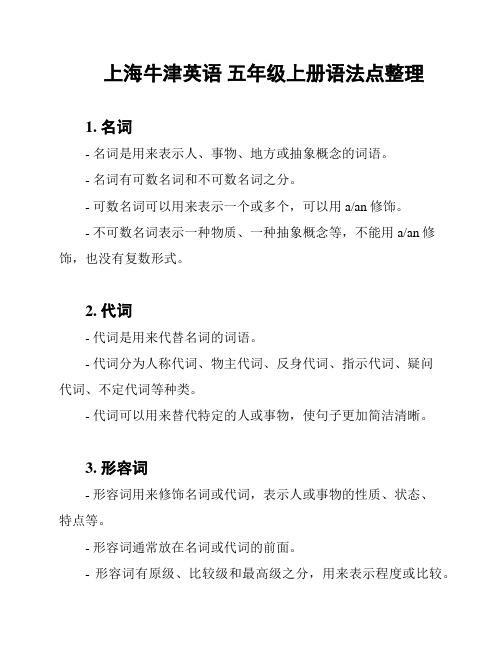
上海牛津英语五年级上册语法点整理1. 名词- 名词是用来表示人、事物、地方或抽象概念的词语。
- 名词有可数名词和不可数名词之分。
- 可数名词可以用来表示一个或多个,可以用a/an修饰。
- 不可数名词表示一种物质、一种抽象概念等,不能用a/an修饰,也没有复数形式。
2. 代词- 代词是用来代替名词的词语。
- 代词分为人称代词、物主代词、反身代词、指示代词、疑问代词、不定代词等种类。
- 代词可以用来替代特定的人或事物,使句子更加简洁清晰。
3. 形容词- 形容词用来修饰名词或代词,表示人或事物的性质、状态、特点等。
- 形容词通常放在名词或代词的前面。
- 形容词有原级、比较级和最高级之分,用来表示程度或比较。
4. 动词- 动词用来表示一个人或事物的动作、状态、存在等。
- 动词分为及物动词和不及物动词。
- 及物动词需要接宾语,不及物动词不需要接宾语。
- 动词的时态有过去时、现在时和将来时等。
5. 副词- 副词用来修饰动词、形容词、副词或整个句子,表示时间、地点、程度等。
- 副词通常放在要修饰的词语之前或之后。
6. 介词- 介词用来表示人或事物之间的关系。
- 介词通常与名词或代词连用,构成介词短语。
- 常见的介词有in、on、at、under等。
7. 冠词- 冠词用来表示名词的特指与泛指。
- 英语中的冠词分为定冠词和不定冠词。
- 定冠词the表示特指,不定冠词a/an表示泛指。
8. 句子- 句子是由主语和谓语构成的完整表达意思的语言单位。
- 句子分为陈述句、疑问句、祈使句和感叹句等种类。
- 句子根据结构可以分为简单句、并列句和复合句。
9. 从句- 从句是句子中的一部分,不能独立成句。
- 从句通常由连词引导,与主句之间存在一定的关系。
- 常见的从句有名词性从句、定语从句和状语从句等。
10. 时态- 时态用来表示动作发生的时间。
- 常见的时态有一般现在时、一般过去时、一般将来时等。
- 时态的使用与句子的主语和谓语的时态有关。
上海牛津小学英语语法知识总结精选文档
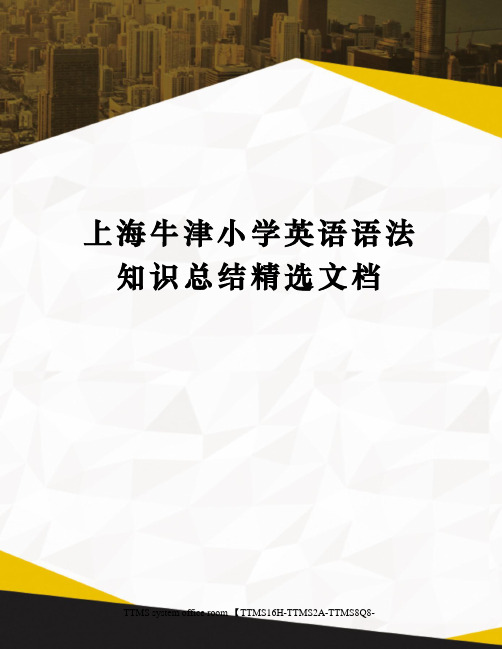
上海牛津小学英语语法知识总结精选文档 TTMS system office room 【TTMS16H-TTMS2A-TTMS8Q8-上海牛津小学英语语法知识总结一般现在时1、定义:表示经常发生或习惯性的动作、状态。
句中通常有usually,often,every day,sometimes,always,at weekends,on Sundays等表示经常性时间的短语。
2、构成:1)当谓语是be动词时,一般现在时的构成:主语+be动词+其他如:I am a student.He is Jim’s father.They are from Japan.2)当谓语是行为动词时,一般现在时的构成:①主语(非第三人称单数)+动词原形+其他如:I often watch TV at the weekends.Mr Green and Mrs Green like collecting stamps.②主语(第三人称单数)+动词的第三人称单数形式+其他如:Jim usually visits his grandparents on Sundays.She sometimes goes to the park with her mother.3、动词三单形式的变化规则:•一般情况下,直接加s 如:read-reads,swim-swims•以s,x,sh,ch,o结尾,加es•如:wash-washes,watch-watches,do-does••以辅音字母+y结尾,变y为i,再加es•如:study-studies,fly-flies••不规则变化如:have-has•4、一般现在时的句型转换:肯定句否定句一般疑问句及回答They watch TV every day. They don’t watch TVevery day.—Do they watch TV every day?—Yes, they do. / No, they don’t.She watches TV every day. She doesn’twatchTV every day.—Does she watch TV every day?—Yes, she does. / No, she doesn’t.现在进行时1、定义:表示现在或现阶段正在进行或发生的动作。
“牛津上海版”小学英语五年级(下)知识点大全
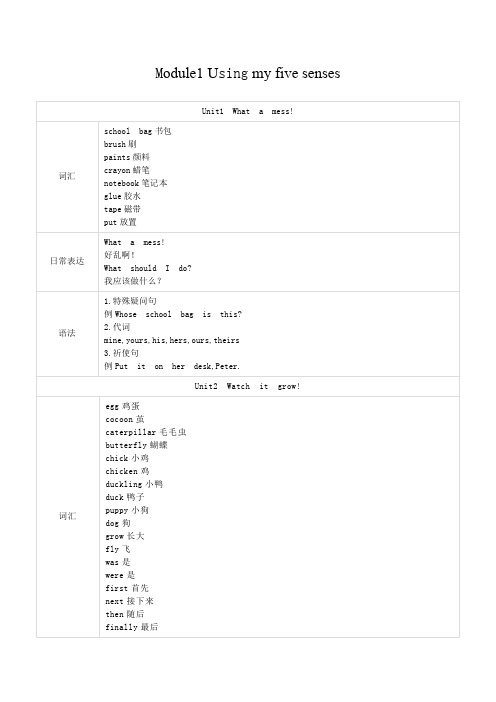
M odule1U sing my five sensesUnit1What a mess!词汇school bag书包brush刷paints颜料crayon蜡笔notebook笔记本glue胶水tape磁带put放置日常表达What a mess!好乱啊!What should I do?我应该做什么?语法1.特殊疑问句例Whose school bag is this?2.代词mine,yours,his,hers,ours,theirs3.祈使句例Put it on her desk,Peter.Unit2Watch it grow!词汇egg鸡蛋cocoon茧caterpillar毛毛虫butterfly蝴蝶chick小鸡chicken鸡duckling小鸭duck鸭子puppy小狗dog狗grow长大fly飞was是were是first首先next接下来then随后finally最后语法1.一般过去时例It was a white egg.2.一般现在时例Now it is a green caterpillar.Unit3How noisy!词汇drill钻(孔);打(眼)lorry卡车motorbike摩托车outside外面sleep睡觉another另外的noise噪音heard听到sat坐日常表达Not at all.一点也不。
语法1.特殊疑问句例What’s that noise?What can you hear?2.一般过去时例Kitty wanted to read a book.M odule2M y favourite thingsUnit1Food and drinks词汇meat肉pork猪肉beef牛肉chicken鸡肉fish鱼肉fruit水果vegetable蔬菜tomato西红柿potato土豆carrot胡萝卜cabbage卷心菜bean豆子rice米饭noodles面条bread面包water水milk牛奶tea茶orange橙子grape葡萄apple苹果banana香蕉drink饮料milk牛奶had有eat吃healthy健康的did做keep...away远离日常表达...is/are my favourite food.是我最喜欢的食物。
期末语法复习(知识清单)牛津上海版(试用本)英语四年级上册
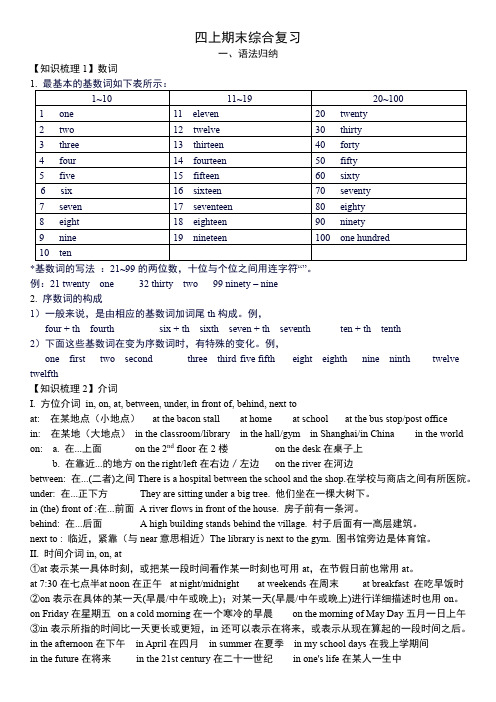
四上期末综合复习一、语法归纳【知识梳理1】数词*基数词的写法:21~99的两位数,十位与个位之间用连字符“”。
例:21 twenty one 32 thirty two 99 ninety – nine2. 序数词的构成1)一般来说,是由相应的基数词加词尾th构成。
例,four + th fourth six + th sixth seven + th seventh ten + th tenth2)下面这些基数词在变为序数词时,有特殊的变化。
例,one first two second three third five fifth eight eighth nine ninth twelve twelfth【知识梳理2】介词I. 方位介词in, on, at, between, under, in front of, behind, next toat: 在某地点(小地点)at the bacon stall at home at school at the bus stop/post officein: 在某地(大地点)in the classroom/library in the hall/gym in Shanghai/in China in the world on: a. 在...上面on the 2nd floor在2楼on the desk在桌子上b. 在靠近...的地方on the right/left在右边/左边on the river在河边between: 在...(二者)之间There is a hospital between the school and the shop.在学校与商店之间有所医院。
under: 在...正下方They are sitting under a big tree. 他们坐在一棵大树下。
in(the) front of:在...前面A river flows in front of the house. 房子前有一条河。
上海 牛津英语五年级下册 语法点详解

上海牛津英语五年级下册语法点详解一、名词的单数和复数名词是指表示事物、人或概念等的名称。
名词有单数和复数形式。
名词的单数表示一个,复数表示多个。
一般情况下,在名词后面加-s可以变成复数形式,但也有一些特殊的规则需要注意。
示例:1.单数:dog(狗)2.复数:dogs(狗)二、动词的现在时态动词用来表示一个动作或状态。
动词有不同的时态,包括过去时态、现在时态和将来时态。
现在时态指的是现在正在发生的动作或状态。
示例:1.I eat an apple.(我吃一个苹果。
)2.___.(她步行去学校。
)三、形容词的比较级和最高级形容词用来描述事物的性质或特征。
形容词有比较级和最高级两种形式。
比较级用于比较两个事物的性质,最高级用于比较三个或更多事物的性质。
示例:1.This is a big book.(这是一本大书。
)2.That book is bigger than this one.(那本书比这本大。
)3.The yellow book is the biggest.(黄色的那本书是最大的。
)四、副词的用法副词是用来修饰动词、形容词或其他副词的词语。
它可以表示时间、地点、程度、方式等含义。
示例:1.___.(他慢慢地走。
)2.___.(她唱得很好听。
)3.They often go to the park.(他们经常去公园。
)五、代词的用法代词是用来代替名词的词语。
它可以指代一个或多个人或事物,有时也可以用来指代整个句子。
示例:1.I like this book。
It is interesting.(我喜欢这本书。
它很有趣。
)2.___.(他们是我的朋友。
我们一起玩。
)六、介词的用法介词是用来表示事物之间的关系的词语。
它通常用在名词或代词前面,用来说明名词或代词与其他词语之间的关系。
示例:1.The cat is on the table.(猫在桌子上。
)2.I went to the park with my friends.(我和我的朋友一起去了公园。
上海牛津小学英语语法知识总结说课材料
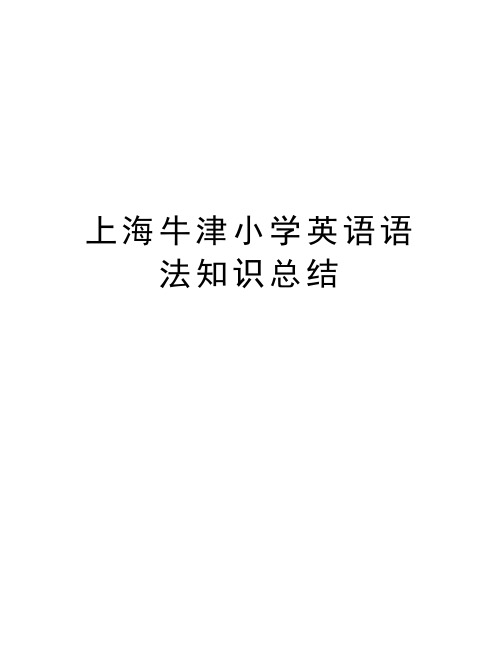
上海牛津小学英语语法知识总结上海牛津小学英语语法知识总结一般现在时定义:表示经常发生或习惯性的动作、状态。
句中通常有usually(通常),often(经常),every day(每天),sometimes(有时),always(总是),at weekends(在周末),on Sundays(在星期天)等表示经常性时间的短语。
构成:1、当谓语是be动词时,一般现在时的构成:主语+be动词+其他如:I am a student(我是一名学生). He is Jim’s father(他是吉姆的爸爸). They are from Japan(他们是来自日本。
).2、当谓语是行为动词时,一般现在时的构成:①主语(非第三人称单数)+动词原形+其他如:I often watch TV at the weekends(我经常在周末看电视).②主语(第三人称单数)+动词的第三人称单数形式+其他如:Jim usually visits his grandparents on Sundays(吉姆通常在周末看望爷爷奶奶。
).3、动词三单形式的变化规则:①如:read-reads,swim-swims②如:wash-washes,watch-watches,do-does③如:study-studies,fly-flies④如:have-has1、Ann (like) Maths. She thinks it is too difficult.(安数学,她认为它太难了)2、Our English teacher always (give) us some useful advice.(我们的英语老师总是给我们一些有用的建议。
)3、It (take)me about eight hours from Shanghai to Wuhu by train.(从上海至芜湖坐火车需花八小时)4、Why does he always (have )toothache?(为什么他总是牙痛?)5、What time (do) your plane leave for Hong Kong tomorrow?(你们的飞机明天几点飞往香港?、6、Peter usually (draw) pictures at home. (彼得总是在家画画。
上海牛津英语六年级英语知识点整理

一、基础语法知识点:
1.句子的构成:主语+谓语+宾语;
2.时态的正确使用:一般现在时、一般过去时、一般将来时等;
3.动词的正确形式及用法:及物动词、不及物动词、系动词等;
4.祈使句的用法:表示请求、命令、建议等;
5.被动语态的用法:一般现在时、一般过去时、一般将来时等;
6. 句子的否定形式:用not把动词或动词短语置于句子前;
7. 祈使句的否定形式:用don’t/doesn’t let +主语+动词原形;
8. 情态动词should、would的用法:表示建议、意愿等;
9.特殊疑问句的构成:疑问词+一般疑问句的构成;
10.形容词、副词的比较级和最高级形式:用于表示物体之间的比较;
11. 名词性从句的引导词:what、who、which等;
12.过去进行时的用法;
二、词汇知识点:
1.常用名词、动词、形容词、副词的基本词义和用法;
2.常见的固定搭配、短语和习惯用法;
3.数词、时间词、量词的用法;
4.常用介词和介词短语的用法;
5.记录、理解并使用常用的固定句型和表达方式;
三、阅读技巧:
1.能够理解并提取文本中的关键信息;
2.能够根据文本内容进行推测和判断;
3.能够根据问题选择正确的答案;
4.能够理解并使用上下文线索;
5.能够根据语境理解单词和短语的意思;
四、写作技巧:
1.能够用正确的语法和用词写出简单连贯的句子;
2.能够运用所学的句型和句式进行书面表达;
3.能够用英语写简单的对话、日记、邮件等;
4.能够根据要求写出简单的说明文、记叙文等;。
- 1、下载文档前请自行甄别文档内容的完整性,平台不提供额外的编辑、内容补充、找答案等附加服务。
- 2、"仅部分预览"的文档,不可在线预览部分如存在完整性等问题,可反馈申请退款(可完整预览的文档不适用该条件!)。
- 3、如文档侵犯您的权益,请联系客服反馈,我们会尽快为您处理(人工客服工作时间:9:00-18:30)。
上海牛津小学英语语法知识总结Document number:PBGCG-0857-BTDO-0089-PTT1998上海牛津小学英语语法知识总结一般现在时1、定义:表示经常发生或习惯性的动作、状态。
句中通常有usually,often,every day,sometimes,always,at weekends,on Sundays等表示经常性时间的短语。
2、构成:1)当谓语是be动词时,一般现在时的构成:主语+be动词+其他如:I am a student. He is Jim’s father. They are from Japan.2)当谓语是行为动词时,一般现在时的构成:①主语(非第三人称单数)+动词原形+其他如:I often watch TV at the weekends.?Mr Green and Mrs Green like collecting stamps.②主语(第三人称单数)+动词的第三人称单数形式+其他如:Jim usually visits his grandparents on Sundays.She sometimes goes to the park with her mother.?3、动词三单形式的变化规则:•一般情况下,直接加s 如:read-reads,swim-swims•以s,x,sh,ch,o结尾,加es 如:wash-washes,watch-watches,do-does•以辅音字母+y结尾,变y为i,再加es 如:study-studies,fly-flies•不规则变化如:have-has•4、一般现在时的句型转换:肯定句否定句一般疑问句及回答They watch TV every day. They don’t watch TVevery day.—Do they watch TV every day—Yes, they do. / No, they don’t.She watches TV every day. She doesn’t watchTV every day.—Does she watch TV every day—Yes, she does. / No, she doesn’t.现在进行时1、定义:表示现在或现阶段正在进行或发生的动作。
句中常有now,look,listen等词。
如:I am washing clothes now.Look! Liu Tao is climbing the tree.Listen! Jane is singing in the music room.2、构成:be动词(am/is/are)+ 动词现在分词(V-ing)3、动词现在分词构成:•一般是在动词原形后加ing如:read-reading,drink-drinking,eat-eating,look-looking•以不发音的e结尾的动词,去掉e,再加ing如:write-writing,make-making,ride-riding,take-taking•以重读闭音节结尾,如末尾只有一个辅音字母,要双写这个字母,再加ing 如:sit-sitting,swim-swimming,put-putting,run-running,stop-stopping,get-getting,begin-beginning,jog-jogging,forget-forgetting4、动名词其实就是动词的现在分词,它既有名词性质(可作主语),又有动词性质(可带宾语)。
如:Asking the wayMy hobby is collecting stamps.He is good at skating.5、现在进行时的句型转换:肯定句否定句一般疑问句及回答He is running now. He isn’t running now. —Is he running now?—Yes, he is. / No, he isn’t.They are making a puppet. They aren’t makinga puppet.—Are they making a puppet?—Yes, they are. / No, theyaren’t.一般过去时1、定义:表示过去某个时间里发生的动作或存在的状态。
常和表示过去的时间状语连用,如:a moment ago,just now,yesterday,last week,this morning等。
•一般在动词原形末尾加ed 如:play-played,listen-listened,look-looked •结尾是e的动词,加d 如:live-lived,like-liked,taste-tasted•辅音字母+y结尾的动词,变y为i,再加ed 如:study-studied,carry-carried,cry-cried•末尾只有一个辅音字母的重读闭音节词,双写这个辅音字母,再加ed 如:stop-stopped,plan-planned•不规则变化如:am/is-was are-were have/has-had do-didgo-went sit-sat tell-told see-sawget-got make-made give-gave read-readbuy-bought come-came draw-drew eat-atefly-flew meet-met put-put run-ransay-said sing-sang swim-swam take-took4、一般过去时的句型转换肯定句否定句一般疑问句及回答He watched TV yesterday. He didn’t watch TVyesterday.—Did he watch TV yesterday—Yes, he did. / No, he didn’t.They played games just now. They didn’t play gamesjust now.—Did they play games just now—Yes, they did. / No, they didn’t.?一般将来时?1、定义:表示将要发生的动作或存在的状态,以及打算、计划或准备某事。
句中一般含有表示将来的时间状语,如:tomorrow morning ,next week ,this afternoon 等表示将来的时间状语。
?2、构成:① be gong to +动词原形?如:I am going to see a Beijing opera tomorrow. We are going to meet at bus stop at half past ten.Dad and I are going to see a Beijing opera this afternoon. ?② will +动词原形?如:They will go swimming this afternoon.3、be going to 和will 区别:① be going to 表示经过事先安排、打算或决定要做的事情,基本上一定会发生;will 则表示有可能去做,但不一定发生,也常表示说话人的临时决定。
如:I am going to take part in a party this evening.The y are cleaning the library now. I’ll go and join them. ?②be going to 表示近期或眼下就要发生的事情;will 表示的将来时间则较远一些。
如:He is going to write a letter tomorrow. I will meet her one day. ?③ be going to 还可以用来表示有迹象表明某件事将要发生,常用于天气等自然现象。
如:Look! It’s going to rain. 4、一般将来时句型转换: 肯定句否定句一般疑问句及回答She is going to have a picnic tomorrow. She isn’t going to have a picnic tomorrow. —Is she going to have apicnic tomorrow —Yes, she is . / No, sheisn’t .They will go swimming this afternoon. They will not(won’t) go swimming this afternoon. —Will they go swimmingthis afternoon —Yes, they will . / No, theywon’t .句法1、陈述句说明事实或陈述说话人观点的句子。
基本结构:主语+谓语+其他 1)肯定陈述句 We all like pandas very much.2)否定陈述句 He doesn’t do housework at weekends ?3)肯定陈述句改否定陈述句①一般是在be 动词或情态动词后加not 。
Mary was at school yesterday. —> Mary was not at school yesterday. I can make a model plane. —>I can not make a model plane. ?②不含be动词或情态动词的,行为动词前要用助动词的否定式(don’t,doesn’t,didn’t),后面跟动词的原形。
He likes drawing pictures.—>He doesn’t like drawing pictures.I went to the park yesterday. —>I didn’t go to the park yesterday.?4)陈述句改一般疑问句①有be动词或情态动词的,把be动词或情态动词提前。
Mary was at school yesterday. —> Was Mary at school yesterdayI can make a model plane. —> Can you make a model plane②不含be动词或情态动词的句子,借助助动词开头,动词还原成原形。
He likes drawing pictures.—>Does he like drawing pictures.I went to the park yesterday. —>Did you go to the park yesterday?2、疑问句用来提出问题,询问情况的句子,末尾用问号。
